1 Vuex 概述
1.1 介绍
Vuex 是一个 Vue 的 状态管理工具,状态就是数据。
大白话:Vuex 是一个插件,可以帮我们管理 Vue 通用的数据 (多组件共享的数据)。例如:购物车数据 个人信息数
1.1.1 使用场景
某个状态 在 很多个组件 来使用 (个人信息)
多个组件 共同维护 一份数据 (购物车)
 68317818664
68317818664
1.1.2 优势
- 共同维护一份数据,数据集中化管理
- 响应式变化
- 操作简洁 (vuex 提供了一些辅助函数)
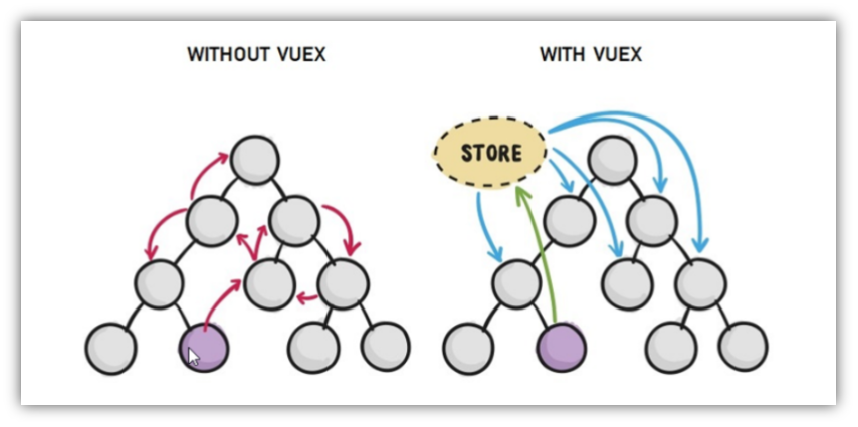 68317829336
68317829336
1.1.3 注意
官方原文:
- 不是所有的场景都适用于 vuex,只有在必要的时候才使用 vuex
- 使用了 vuex 之后,会附加更多的框架中的概念进来,增加了项目的复杂度 (数据的操作更便捷,数据的流动更清晰)
1.2 vuex 的使用
 68321278417
68321278417
1.2.1 安装 vuex
安装 vuex 与 vue-router 类似,vuex 是一个独立存在的插件,如果脚手架初始化没有选 vuex,就需要额外安装。
1
2
|
yarn add vuex@3 或者 npm i vuex@3
BASH
|
1.2.2 store/index.js 专门存放 vuex
为了维护项目目录的整洁,在 src 目录下新建一个 store 目录其下放置一个 index.js 文件。 (和 router/index.js 类似)
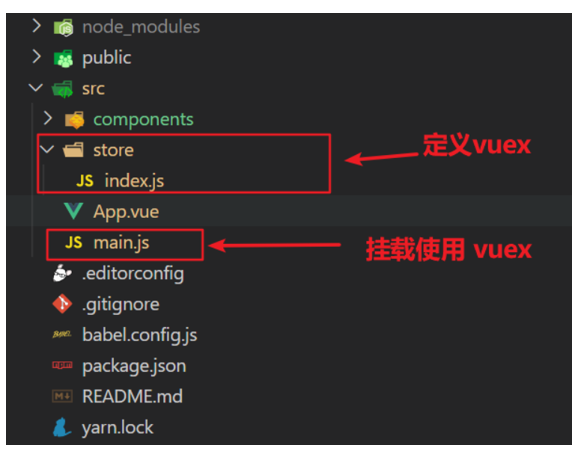 68321280582
68321280582
1.2.3 创建仓库 store/index.js
1
2
3
4
5
6
7
8
9
10
11
|
import Vue from 'vue'
import Vuex from 'vuex'
Vue.use(Vuex)
const store = new Vuex.Store()
export default store
JSX
|
1.2.4 在 main.js 中导入挂载到 Vue 实例上
1
2
3
4
5
6
7
8
9
10
| import Vue from 'vue'
import App from './App.vue'
import store from './store'
Vue.config.productionTip = false
new Vue({
render: h => h(App),
store
}).$mount('#app')
JS
|
此刻起, 就成功创建了一个 空仓库!!
1.2.5 测试打印 Vuex
App.vue
1
2
3
| created(){
console.log(this.$store)
}
JS
|
2 核心概念
2.1 状态 state
2.1.1 单一状态树
明确如何给仓库 提供 数据,如何 使用 仓库的数据
1.提供数据
State 提供唯一的公共数据源,所有共享的数据都要统一放到 Store 中的 State 中存储。
打开项目中的 store.js 文件,在 state 对象中可以添加我们要共享的数据。
1
2
3
4
5
6
7
8
9
10
|
const store = new Vuex.Store({
state: {
count: 101
}
})
JSX
|
2.访问 Vuex 中的数据
- 通过 $store 直接访问 —>
{{ $store.state.count }} - 通过辅助函数 mapState 映射计算属性 —>
{{ count }}
3.通过 $store 访问的语法
1
2
3
4
5
6
7
8
| 获取 store:
1.Vue 模板中获取 this.$store
2.js 文件中获取 import 导入 store
模板(没有 this)中: {{ $store.state.xxx }}
组件逻辑中: this.$store.state.xxx
JS模块中: store.state.xxx
JS
|
4.代码实现
模板中使用
组件中可以使用 $store 获取到 vuex 中的 store 对象实例,可通过 state 属性属性获取 count, 如下
1
| <h1>state的数据 - {{ $store.state.count }}</h1>
VUE
|
组件逻辑中使用
将 state 属性定义在计算属性中 https://vuex.vuejs.org/zh/guide/state.html
1
2
3
4
5
6
7
8
| <h1>state的数据 - {{ count }}</h1>
computed: {
count () {
return this.$store.state.count
}
}
JS
|
js 文件中使用
1
2
3
4
|
import store from "@/store"
console.log(store.state.count)
JAVASCRIPT
|
每次都像这样一个个的提供计算属性, 太麻烦了,我们有没有简单的语法帮我们获取state中的值呢?
2.1.2 辅助函数 mapState
mapState 是辅助函数,帮助我们把 store 中的数据映射到组件的计算属性中, 它属于一种方便的用法
用法 :
 68321471957
68321471957
1.导入 mapState (mapState 是 vuex 中的一个函数)
1
| import { mapState } from 'vuex'
JS
|
2.采用数组形式引入 state 属性
上面代码的最终得到的是 类似于 计算属性添加了对应的数据
1
2
3
| count () {
return this.$store.state.count
}
JS
|
3.利用展开运算符将导出的状态映射给计算属性
1
2
3
| computed: {
...mapState(['count'])
}
JS
|
1
| <div> state的数据:{{ count }}</div>
VUE
|
2.2 开启严格模式及 Vuex 的单向数据流
明确 vuex 同样遵循单向数据流,组件中不能直接修改仓库的数据
直接在组件中修改Vuex中state的值
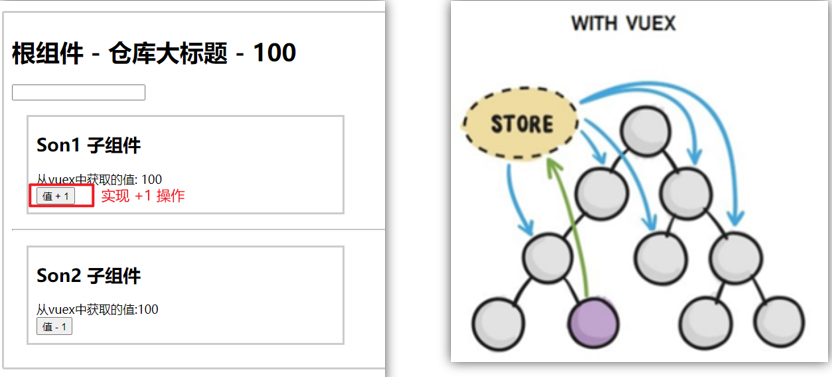 68321589228
68321589228
Son1.vue
1
2
3
4
5
6
7
8
9
10
| button @click="handleAdd">值 + 1</button>
methods:{
handleAdd (n) {
this.$store.state.count++
},
}
JAVASCRIPT
|
开启严格模式
通过 strict: true 可以开启严格模式,开启严格模式后,直接修改 state 中的值会报错
state 数据的修改只能通过 mutations,并且 mutations 必须是同步的
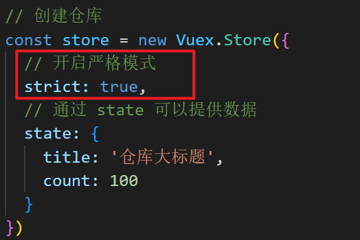 68321471957
68321471957
2.3 Mutation
2.3.1 介绍
1.定义 mutations
1
2
3
4
5
6
7
8
9
| const store = new Vuex.Store({
state: {
count: 0
},
mutations: {
}
})
JS
|
2.格式说明
mutations 是一个对象,对象中存放修改state的方法
1
2
3
4
5
6
7
| mutations: {
addCount (state) {
state.count += 1
}
},
JS
|
3.组件中提交 mutations
1
| this.$store.commit('addCount')
JSX
|
4.总结
通过 mutations 修改 state 的步骤
1.定义 mutations 对象,对象中存放修改 state 的方法
2.组件中提交调用 mutations(通过 $store.commit(‘mutations的方法名’))
2.3.2 提交载荷(Payload)
可以向 store.commit 传入额外的参数,即 mutation 的载荷(payload)
语法
看下面这个案例,每次点击不同的按钮,加的值都不同,每次都要定义不同的mutations处理吗?
 68321700423
68321700423
提交 mutation 是可以传递参数的 this.$store.commit('xxx', 参数)
2.1 提供mutation函数(带参数)
1
2
3
4
5
6
| mutations: {
...
addCount (state, count) {
state.count = count
}
},
JS
|
2.2 提交mutation
1
2
3
| handle ( ) {
this.$store.commit('addCount', 10)
}
JSX
|
小tips: 提交的参数只能是一个, 如果有多个参数要传, 可以传递一个对象。
在大多数情况下,载荷应该是一个对象,这样可以包含多个字段并且记录的 mutation 会更易读
1
2
3
| this.$store.commit('addCount', {
count: 10
}
JSX
|
2.3.3 mapMutations
mapMutations 和 mapState 很像,它把位于 mutations 中的方法提取了出来,我们可以将它导入
1
2
3
4
| import { mapMutations } from 'vuex'
methods: {
...mapMutations(['addCount'])
}
JS
|
上面代码的含义是将 mutations 的方法导入了 methods 中,等价于
1
2
3
4
5
6
| methods: {
addCount () {
this.$store.commit('addCount')
}
}
JS
|
此时,就可以直接通过 this.addCount 调用了
1
| <button @click="addCount">值+1</button>
JSX
|
但是请注意: Vuex 中 mutations 中要求不能写异步代码,如果有异步的 ajax 请求,应该放置在 actions 中。
2.4 Action
state 是存放数据的,mutations 是同步更新数据 (便于监测数据的变化, 更新视图等, 方便于调试工具查看变化),
actions 则负责进行异步操作
说明:mutations 必须是同步的
需求: 一秒钟之后,要给一个数去修改 state
 68321860367
68321860367
1.定义 actions
1
2
3
4
5
6
7
8
9
10
11
12
13
14
15
| mutations: {
changeCount (state, newCount) {
state.count = newCount
}
}
actions: {
setAsyncCount (context, num) {
setTimeout(() => {
context.commit('changeCount', num)
}, 1000)
}
},
JS
|
2.组件中通过 dispatch 调用
Action 通过 store.dispatch 方法触发:
1
| store.dispatch('increment')
JAVASCRIPT
|
如下:
1
2
3
| setAsyncCount () {
this.$store.dispatch('setAsyncCount', 666)
}
HAXE
|
 68344198757
68344198757
2.4.1 mapActions
1.目标:掌握辅助函数 mapActions,映射方法
mapActions 是把位于 actions 中的方法提取了出来,映射到组件 methods 中
Son2.vue
1
2
3
4
5
6
7
8
9
10
11
| import { mapActions } from 'vuex'
methods: {
...mapActions(['changeCountAction'])
}
JS
|
直接通过 this.方法 就可以调用。
1
| <button @click="changeCountAction(200)">+异步</button>
VUE
|
2.5 Getter
除了 state 之外,有时我们还需要从 state 中筛选出符合条件的一些数据,这些数据是依赖 state 的,此时会用到 getters
例如,state 中定义了 list,为 1-10 的数组,
1
2
3
| state: {
list: [1, 2, 3, 4, 5, 6, 7, 8, 9, 10]
}
JS
|
组件中,需要显示所有大于 5 的数据,正常的方式,是需要 list 在组件中进行再一步的处理,但是 getters 可以帮助我们实现它
2.5.1 定义 getters
1
2
3
4
5
| getters: {
filterList: state => state.list.filter(item => item > 5)
}
JS
|
2.5.2 使用 getters
原始方式-$store
1
| <div>{{ $store.getters.filterList }}</div>
VUE
|
辅助函数 - mapGetters
1
2
3
| computed: {
...mapGetters(['filterList'])
}
JS
|
1
| <div>{{ filterList }}</div>
VUE
|
2.6 使用小结
 68344213391
68344213391
2.7 Module
由于使用 单一状态树,应用的所有状态 会集中到一个比较大的对象。当应用变得非常复杂时,store 对象就有可能变得相当臃肿。
这句话的意思是,如果把所有的状态都放在 state 中,当项目变得越来越大的时候,Vuex 会变得越来越难以维护
由此,又有了 Vuex 的模块化。
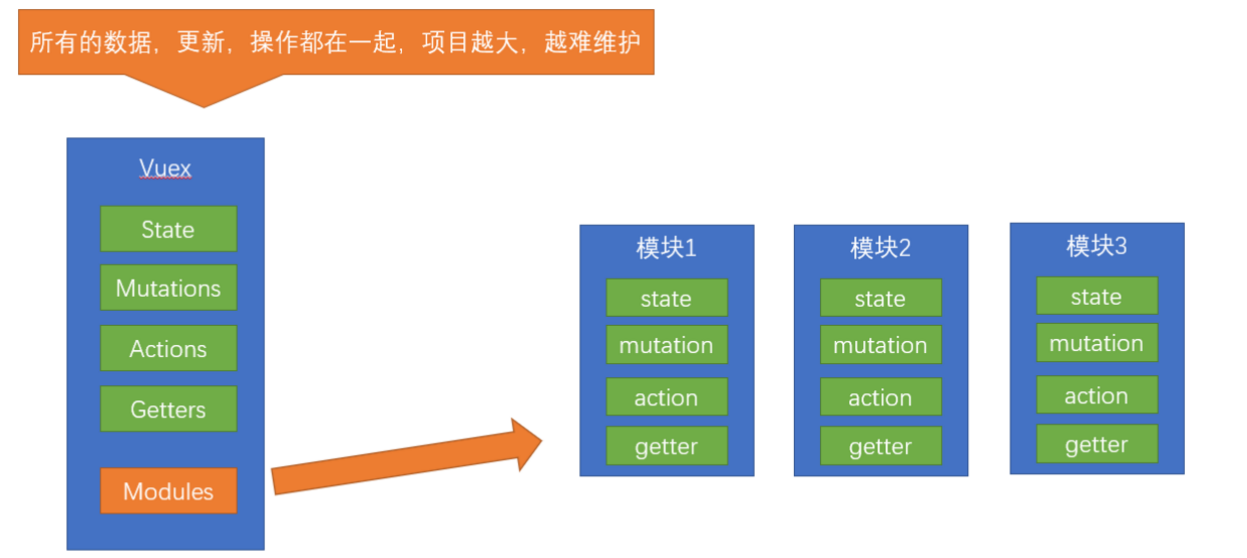 68342575835
68342575835
准备 state
定义两个模块 user 和 setting
user中管理用户的信息状态 userInfo modules/user.js
1
2
3
4
5
6
7
8
9
10
11
12
13
14
15
16
17
18
19
| const state = {
userInfo: {
name: 'zs',
age: 18
}
}
const mutations = {}
const actions = {}
const getters = {}
export default {
state,
mutations,
actions,
getters
}
JSX
|
setting 中管理项目应用的,主题色 theme,描述 desc, modules/setting.js
1
2
3
4
5
6
7
8
9
10
11
12
13
14
15
16
17
| const state = {
theme: 'dark'
desc: '描述真呀真不错'
}
const mutations = {}
const actions = {}
const getters = {}
export default {
state,
mutations,
actions,
getters
}
JSX
|
在 store/index.js 文件中的 modules 配置项中,注册这两个模块
1
2
3
4
5
6
7
8
9
| import user from './modules/user'
import setting from './modules/setting'
const store = new Vuex.Store({
modules:{
user,
setting
}
})
JS
|
使用模块中的数据, 可以直接通过模块名访问 $store.state.模块名.xxx => $store.state.setting.desc
也可以通过 mapState 映射。
3 项目化-获取模块内信息
3.1 获取模块内的 state 数据
尽管已经分模块了,但其实子模块的状态,还是会挂到根级别的 state 中,属性名就是模块名。
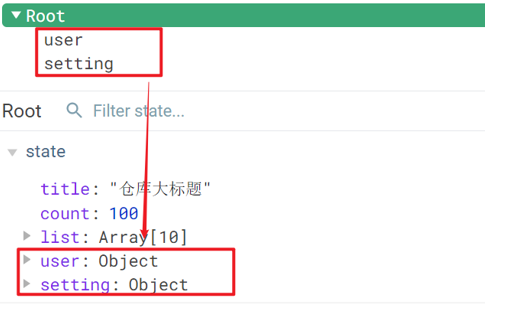 68342784166
68342784166
使用模块中的数据
- 直接通过模块名访问
$store.state.模块名.xxx - 通过 mapState 映射:
- 默认根级别的映射:
mapState([ 'xxx' ]) - 子模块的映射:
mapState('模块名', ['xxx']) - 需要开启命名空间 namespaced:true
modules/user.js
1
2
3
4
5
6
7
8
9
10
11
12
13
14
15
16
17
18
19
20
21
22
23
24
25
| const state = {
userInfo: {
name: 'zs',
age: 18
},
myMsg: '我的数据'
}
const mutations = {
updateMsg (state, msg) {
state.myMsg = msg
}
}
const actions = {}
const getters = {}
export default {
namespaced: true,
state,
mutations,
actions,
getters
}
JSX
|
代码示例
$store 直接访问
1
| $store.state.user.userInfo.name
JS
|
mapState 辅助函数访问
1
2
| ...mapState('user', ['userInfo']),
...mapState('setting', ['theme', 'desc']),
JS
|
3.2 获取模块内的 getters 数据
使用模块中 getters 中的数据:
- 直接通过模块名访问
$store.getters['模块名/xxx '] - 通过 mapGetters 映射
- 默认根级别的映射
mapGetters([ 'xxx' ]) - 子模块的映射
mapGetters('模块名', ['xxx']) - 需要开启命名空间
代码演示
modules/user.js
1
2
3
4
5
6
| const getters = {
UpperCaseName (state) {
return state.userInfo.name.toUpperCase()
}
}
JS
|
Son1.vue 直接访问 getters
1
2
|
<div>{{ $store.getters['user/UpperCaseName'] }}</div>
HTML
|
Son2.vue 通过命名空间访问
1
2
3
| computed:{
...mapGetters('user', ['UpperCaseName'])
}
JS
|
3.3 获取模块内的 mutations 方法
默认模块中的 mutation 和 actions 会被挂载到全局,需要开启命名空间,才会挂载到子模块。
调用方式
- 直接通过 store 调用
$store.commit('模块名/xxx', 额外参数) - 通过 mapMutations 映射
- 默认根级别的映射
mapMutations([ 'xxx' ]) - 子模块的映射
mapMutations('模块名', ['xxx']) - 需要开启命名空间
代码实现
modules/user.js
1
2
3
4
5
| const mutations = {
setUser (state, newUserInfo) {
state.userInfo = newUserInfo
}
}
JS
|
modules/setting.js
1
2
3
4
5
| const mutations = {
setTheme (state, newTheme) {
state.theme = newTheme
}
}
JS
|
Son1.vue
1
2
3
4
5
6
7
8
9
10
11
12
13
14
15
16
17
18
| <button @click="updateUser">更新个人信息</button>
<button @click="updateTheme">更新主题色</button>
export default {
methods: {
updateUser () {
this.$store.commit('user/setUser', {
name: 'xiaowang',
age: 25
})
},
updateTheme () {
this.$store.commit('setting/setTheme', 'pink')
}
}
}
JAVASCRIPT
|
Son2.vue
1
2
3
4
5
6
7
8
| <button @click="setUser({ name: 'xiaoli', age: 80 })">更新个人信息</button>
<button @click="setTheme('skyblue')">更新主题</button>
methods:{
// 分模块的映射
...mapMutations('setting', ['setTheme']),
...mapMutations('user', ['setUser']),
}
VUE
|
3.4 获取模块内的 actions 方法
注意:
默认模块中的 mutation 和 actions 会被挂载到全局,需要开启命名空间,才会挂载到子模块。
调用语法:
- 直接通过 store 调用
$store.dispatch('模块名/xxx', 额外参数) - 通过 mapActions 映射
- 默认根级别的映射
mapActions([ 'xxx' ]) - 子模块的映射
mapActions('模块名', ['xxx']) - 需要开启命名空间
代码实现
需求:
 68343161569
68343161569
modules/user.js
1
2
3
4
5
6
7
8
9
| const actions = {
setUserSecond (context, newUserInfo) {
setTimeout(() => {
context.commit('setUser', newUserInfo)
}, 1000)
}
}
JS
|
Son1.vue 直接通过 store 调用
1
2
3
4
5
6
7
8
9
10
11
| <button @click="updateUser2">一秒后更新信息</button>
methods:{
updateUser2 () {
// 调用action dispatch
this.$store.dispatch('user/setUserSecond', {
name: 'xiaohong',
age: 28
})
},
}
VUE
|
Son2.vue mapActions 映射
1
2
3
4
5
| <button @click="setUserSecond({ name: 'xiaoli', age: 80 })">一秒后更新信息</button>
methods:{
...mapActions('user', ['setUserSecond'])
}
JS
|
3.5 Vuex 模块化的使用小结
3.5.1 直接使用
1
2
3
4
| 1. state --> $store.state.**模块名**.数据项名
2. getters --> $store.getters['**模块名**/属性名']
3. mutations --> $store.commit('**模块名**/方法名', 其他参数)
4. actions --> $store.dispatch('**模块名**/方法名', 其他参数)
JAVASCRIPT
|
3.5.2 借助辅助方法使用
1
2
3
4
5
6
7
8
| import { mapXxxx, mapXxx } from 'vuex'
computed、methods: {
...mapXxxx(**'模块名'**, ['数据项|方法']),
...mapXxxx(**'模块名'**, {'新的名字: 原来的名字'}),
}
JAVASCRIPT
|
2.组件中直接使用 属性 {{ age }} 或 方法 @click="updateAge(2)"













